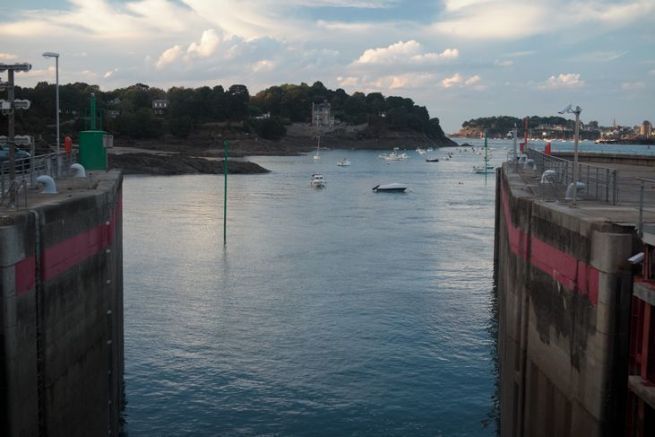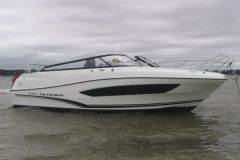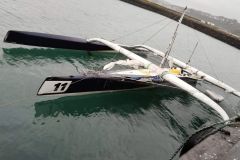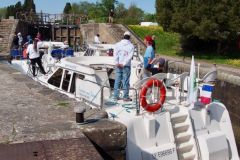A dam on the sea?
It was on 26 November 1966 that the President of the Republic Charles de Gaulle officially put an end to the impossible road accessibility of the two banks of the Rance, making the Malouins and Dinardais roads meet. The inauguration of the dam on the Rance then created the largest tidal power plant in the world. It will be dethroned in 2011 by the Korean power station on Lake Sihwa. 750 meters long, the "Rance Dam" is equipped with a lock that connects the sea to the water body. Although it does not present any difficulty strictly speaking, crossing this lock can be impressive, the sensation of crossing an immense building is real and the amateur boater can feel crushed by the size of the building. All the more so since it must be recognized that, on certain summer evenings, local boaters who are well used to this passage make little effort to assist or even simply be sympathetic to the passing boater who may have some difficulty with his boat.
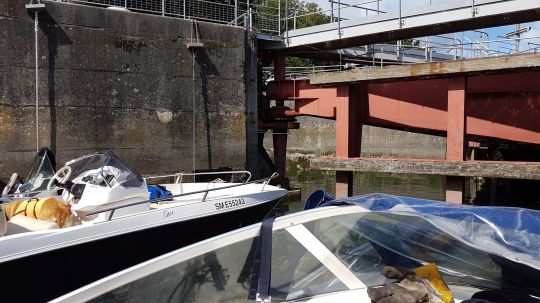
Basic Principles

The fundamentals of passing through any lock are present here:
- Red lights no access,
- Green light access to the airlock authorizes
- Green and white lights, contact (VHF Channel 13 or 02 99 16 37 37).
Protections (fenders) at the station, each crew member wears his life jacket and everyone knows what he has to do (who will catch a hawser, who will handle the gaff...).
The dam is in operation 24 hours a day, 7 days a week, on presentation from 5 a.m. to 8 p.m. in the evening, by contacting (by VHF or telephone) outside these hours. Finally, there is a call cord on the dukes of albes present on each side of the building.
All you have to do is wait for the lock's opening time to arrive and for sufficient water level to be present . That's when things can get complicated. Depending on whether you are on the sea side or the rancid side, you will have to arrive at the lock 20 minutes before the schedule ( in the direction Rance towards the sea ) or 5 minutes before the schedule ( the other way around ) to enter the airlock. In all cases, if your draught exceeds 1.80 m, you must contact the lock operator and advise him of this specificity. If there is less than 4 m of water announced at your arrival... No luck, you will have to wait a little longer, passages in both directions are only possible if the sea level is at least 4 meters.
You wait, engine stopped out of respect for the environment, the neighbours and the surrounding vessels, boat moored to one of the waiting buoys present upstream and downstream of the lock. When the colour of the lights changes, you have plenty of time to enter the lock chamber, at a very low speed and in peace and quiet.
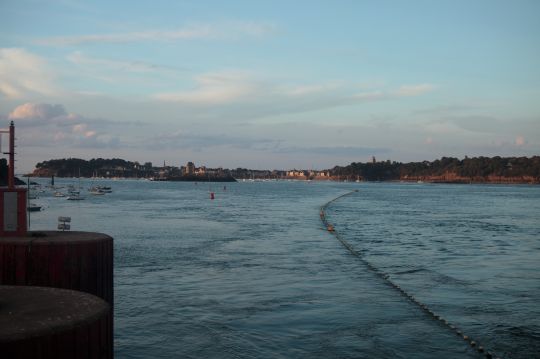
Near the dam, whether on the sea side or the rancid side, you will see a string of red buoys marked "ZI". These buoys delimit the forbidden access zone near the gates feeding the dam's turbines. It is totally forbidden ( besides being dangerous ) to voluntarily access this area. In the unlikely event that you lose control of your boat, you may be stopped by the safety net surrounding the area, but you should consider that you are in immediate danger and adopt normal procedure ( contact the lock keeper by VHF on channel 13, otherwise launch a mayday on channel 16, set off a distress flare.. ) and, above all, do not leave the ship to go to any tender or lifeboat. The lock keepers will be warned by the monitoring devices of your intrusion and will be able to assist you if necessary (you will probably need them, watching the strength of the current produced by the turbines is enough to understand the risk involved).
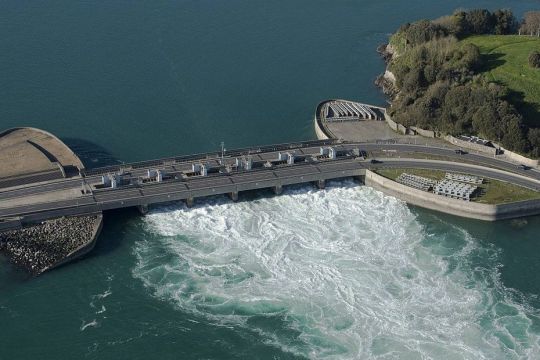
Finally, semaphores are used to determine the direction of the current ( sea to estuary or vice versa ) :
- Cones pointing down on at least one of the masts, the estuary empties ( the sea "fills up" )
- Cones pointing upwards, it's the other way around ( the sea is "emptying" )
This information is far from insignificant, the current generated by the turbines can be felt "strong" over several kilometres in Rance, several miles at sea.
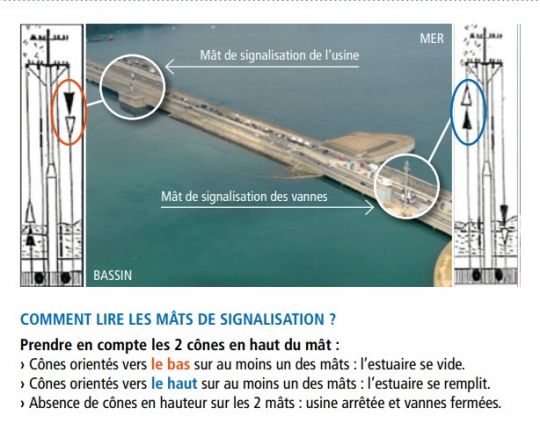
Is the light green?
You'll be able to enter the airlock, quietly and at a walking pace. Depending on whether you are a boat with a mast or not, you will enter among the first or among the last. The principle here is to cut off traffic for as little time as possible. So, if you are going towards the sea (so you are in Rance) the boats with a shallow draft come first. If you go back to the Rance (and you are at sea), it is the opposite, the shallow draught boats go last.

Once you enter the airlock, identify the hawser you are targeting and inform your active crew. There is, unfortunately, no identification method present on these hawsers (suggestion to be made at the barrage?), so everyone on board knows what your intention is. As a matter of principle, don't rely on anyone other than your crew to reach the place in question, don't listen to the other boaters present, especially if they grumble or show some discontent. The sole and unique authority in the lock chamber rests with the lock operator and no one else.
Once you have moored your boat, turn off the engine. Make sure at least one crew member is on standby and will know how to operate your mooring lines when the water level rises or falls and ... wait. Take this opportunity to prepare the necessary ends for all cleats (5 meters per cleat), that the fenders are in place, that everyone wears a vest and shoes... Make sure that you will perform this manoeuvre safely and calmly. Warn your crew that from the moment you are going to restart the engine to the moment you are going to stop it, you only want to see on deck those who have to do it. It is your authority as skipper that must prevail here.
Generally speaking, it takes 20 minutes to pass the lock of the dam on the Rance River, rarely more. The basic principle is to maneuver gently and calmly. A slow manoeuvre is more likely to succeed than a fast one, and in case of collision with another vessel (even though everyone is supposed to protect their boat with fenders), there is less risk of damage at low speed.
Safety and usage rules
As with any crossing of a marine obstacle, the passage of the dam lock presents risks, which must never be minimized. This is why EDF, the operator of the Rance dam, publishes on its website a set of advice and recommendations for use.
Among the few rules we think it is useful to remember:
- Proceed with calm and relaxation
- If a manoeuvre fails (you miss the intended hawser), contact your crew, apologize and aim for another one
- If you hit another boat, given your low speed, there is little risk of damage. Again, apologise to the boat owner and, if damage occurs, agree to meet after the sluice and outside the lock to do the necessary paperwork, to avoid creating a blockage in the lock chamber on the one hand, and on the other hand to let the pressure drop a little bit from both sides
- Each team member will be wearing
- Each crewmember will wear his lifejacket
- Only those crew members on deck will be present as long as the boat is not moored.
- The fenders are in place and the boom(s) are within reach
- Ends are placed on all possible cleats, at least 5 metres long
- No foot, hand or leg protrudes from the edge.
Once past?
Once you have passed the dam, call the lock keeper and thank him for this passage, it doesn't cost anything and no doubt it will please him, the regulars tend to contact this public service agent only to grumble.
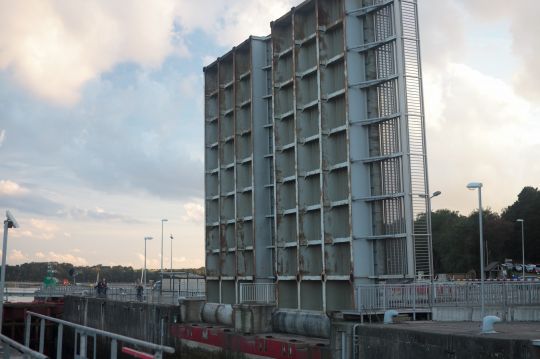
To know more about it
EDF offers a whole range of documentation on the website dedicated to the dam, documentation which will enable you to get to know the dam better and to prepare your passage better, by consulting the possible crossing times, water levels, any administrative restrictions...

 /
/ 